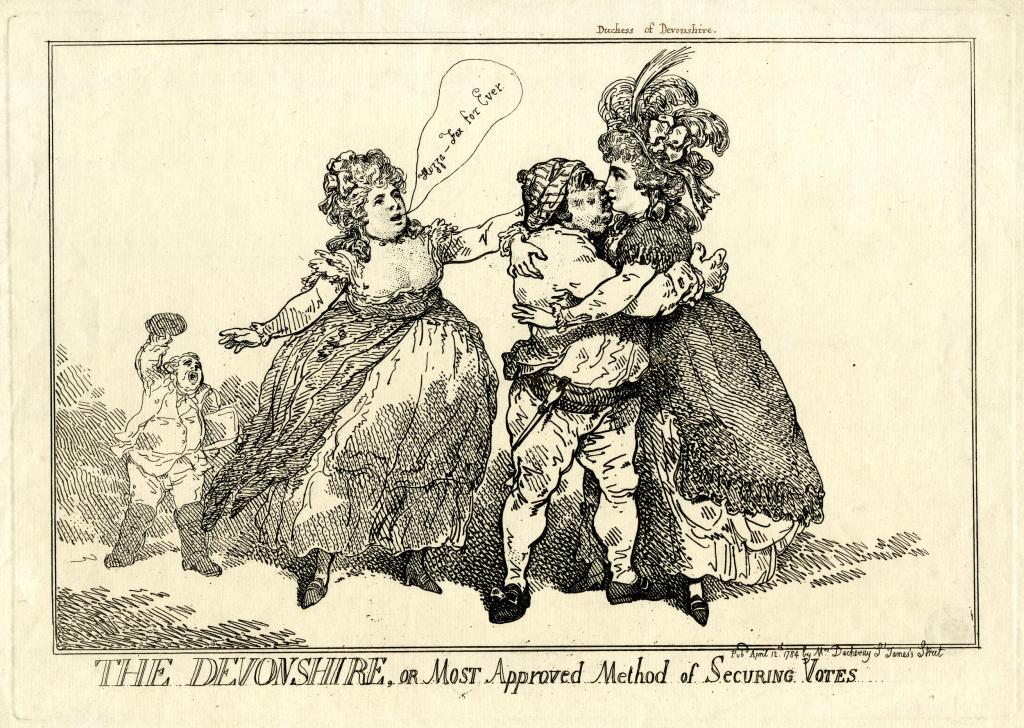In an age of social media and immediate news coverage, publicity opportunities have become a central part of political strategy- particularly in the run up to a General Election. But even in the 18th century politicians looked for ways to generate attention when on the campaign trail. Dr Robin Eagles, editor of our House of Lords 1715-1790 project, looks at some of these in the latest blog in our Georgian Elections Project…
Modern elections are all about photo opportunities. Some party leaders have made a speciality of pulling off stunts in front of the cameras, while others have become the victims of popular protest.
Of course, the 18th-century had no cameras to log the progress of campaigns, but that did not mean politicians were any less likely to seek opportunities of showing themselves among their voters, and indulging in big gestures to attract or shore up their support base. There was also a lively print culture based around satires, ballads and squibs to keep people engaged in the campaign whether or not they were able to vote themselves.
At the most basic level, candidates of all stamps worked to woo their voters by throwing entertainments. Distinctions were often made between the more respectable figures in the constituency, who might be invited to a dinner at an inn or the candidate’s own home, and the rest of the locals, who were treated to barrels full of beer and perhaps a roast or two to enjoy en plein air. That the dinners were carefully tailored is indicated by John Wilkes’ correspondence with his election agent when he was contesting Aylesbury, in which he made it plain that one local voter was not welcome at the dinner he was planning for the electorate.

Some of the more hotly contested elections, though, attracted bigger gestures as members of the candidates’ support-base waded in to help their man over the line. One of the best known was in 1784 when Charles James Fox, under pressure to retain his seat as MP for Westminster, was championed by a group of fashionable aristocratic women, led by the duchess of Devonshire, who supposedly offered kisses in return for votes. Unsurprisingly, this inspired a raft of satires, including The Devonshire, or Most Approved Method of Securing Votes, showing the duchess mid-embrace being harangued by a sex-worker shouting out encouragingly, ‘Huzza – Fox for Ever’.
Devonshire was not alone in playing an active role in the election, being just one of a bevy of supporters for Fox, who faced off against a similarly active set of grandees backing Pittite candidates, including the duchesses of Rutland and Argyll. All came in for abuse of one kind or another in the press, but one of Pitt’s female supporters, Mrs Hobart, attracted particular attention. As Elaine Chalus has observed, she was perhaps less usual in the world of the 1784 campaign, in that she was lampooned ‘for her obesity and awkwardness’ unlike Devonshire who was famous for her glamour. [Chalus, 213] One satire in particular, ‘Madam Blubber’s Last shift or the Aerostatic Dilly’ depicted Hobart atop a balloon carrying two voters towards the polls at Covent Garden. Watching her, off to one side, one candidate comments ‘A foul wind is fair for us’.

At their worst, 18th-century elections could be brutal affairs. In one of the many elections for Middlesex during the Wilkite agitation that rocked the constituency, one member of the public was killed by heavies hired by the other side. The extent of the violence of the December 1768 by-election, contested between the Wilkite candidate, Glynn, and the ministerialist Beauchamp Proctor, was captured in at least one print, ‘The Brentford Election’, named after the county town where the poll took place. It shows the moment where the hustings was rushed by bludgeon-wielding hired thugs with two women among those knocked to the floor.
![Satire on the attack on the Brentford hustings during the Middlesex election in December 1768 by supporters of the ministerial candidate, Sir William Beauchamp Procter. A mob, armed with heavy bludgeons advances under a banner lettered “Liberty and P[rocte]r “; one man better dressed than the rest has a cockade in his hat. Three women are among those attacked: one carrying a child, one an old widow, the other a market woman. A man defending the hustings shouts, “D(amm) you dogs we’ll match you all presently”; two attackers cry “Bring down the Poll Book P[rocter] shall be the Man”. “For a Guinea a Day / Damn Glyn & all his friends”. John Wilkes stands to the right smiling and holding his finger to his nose indicating that there will be trouble. In the background two men rush up some steps to the polling booth.
An impression from this plate faces page 228 of the Oxford Magazine, 1768
Etching and engraving](https://thehistoryofparliament.wordpress.com/wp-content/uploads/2024/06/364255001.jpg?w=1024)
It was not just those in the crowd who risked injury. Candidates might also expect to be pelted by a variety of objects: a particular favourite of the crowd being dead cats. One print produced by Henry Sadd, after Robert Dighton, for the 1796 Westminster election shows the candidates on the hustings at Covent Garden with a crowd in front. Most seem good-humoured, but in the foreground one can detect a small child with a dead cat in his hand, getting ready to throw it at the platform. In another from 1784 called The Mask, showing a candidate addressing the crowd from the hustings, a dead animal can be seen flying through the air.
RDEE
Further Reading:
Elaine Chalus, Elite Women in English Political Life, c.1754-1790 (2005)
Find our full Georgian Elections Project here, and keep an eye on our TikTok channel for future videos on hustings and satirical prints during 18th century elections!

